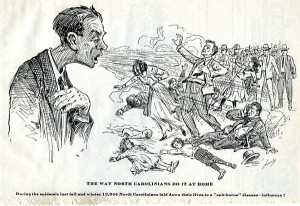Bane of Bayes
On this blog I’ve made numerous indirect references to my job (e.g., postings my work trips to China, Istanbul, and Kathmandu; NIH 5k runs; and of course the famous colleagues from Italy, Alice & Isabella). But I haven’t written much about what I actually do for my job, mainly because it never related much to running except for taking me to cool new places to run. But this this weekend was different, on Saturday my work and running worlds fully collided. I was entirely planning to run a 4-mile PR Twilight Race in Ashburn at 7:30pm on Saturday night. But work was making me, as my Jewish mom would say, meshugana (meshugana is yiddish for crazy person; my mom tends to use it more to mean a temporary crazy spell). And to explain why I’d gone meshugana I have to relate a little about what I actually do for a living besides constantly travel to exotic countries.
Most people know that I’m a biologist who studies viruses at the NIH. Some can elaborate that I don’t do ‘wet lab’ (ie anything that involves a pipet or rubber gloves) but do computer analysis of the genetic sequences of rapidly evolving RNA viruses like influenza. Those who get extra big cookies can say that studying the evolution of influenza viruses is important for several reasons: (a) the virus evolves so quickly that the influenza vaccine must be updated annually with new strains, and predicting new strains remains a major public health challenge, and (b) there is a lot about the seasonality and spatial spread of influenza that we still don’t understand, and you can use genetic data to study spatial and epidemiological patterns in very fine detail. Since the 2009 swine-origin influenza pandemic, I’ve been studying influenza increasingly in pigs.
I love so many aspects of my job — I have a lot of freedom to follow my curiosity and pick my own projects, and to work in various locations — home, West Virginia, with my PhD adviser at Penn State, or in my lovely little office in an old mansion on the NIH campus, I have really wonderful colleagues (Alice and Isabella as cases in point), and I get to travel to very cool places to collaborate on work projects. But there is one part of my job that drives me nutty, hair-pulling nutty, and that is Bayesian analysis.
The crux of my work involving inferring phylogenetic trees from hundreds of viral sequences to visualize the evolutionary history of the viruses and how viruses collected at different times and in difference geographical places are related. [For the very, very few of you interested in more detail, a nice review of the applications of evolutionary analysis of influenza to uncover basic viral characteristics like seasonality, spatial spread, and drug resistance is available: nelson-holmes-evolution-epidemic-influenza-NRG-07]. Phylogenetic trees (such as the classic one showing the genetic relatedness of humans, chimps, gorillas, and other apes) are central to the concept of evolution and even Darwin sketched a loose vision of a phylogenetic tree in his notebooks to explain the notion of common ancestry among organisms.

Darwin's tree, sketched in his notebook under the words 'I think' has become a popular tattoo. I wonder if this girl can help me with my Bayesian phylogenetic analyses.
There are many different computational methods for inferring a phylogenetic tree, with the general trade-off being that slower, more computationally intensive methods generally more accurate trees, while quick-and-dirty methods are faster but make more assumptions. Currently in vogue are Bayesian trees that incorporate prior assumptions (based on empirical evidence) and that produce not a single tree but an entire distribution of trees (generally 10,000 or so) with different probabilities of being the ‘real’ tree. The Markov chain Monte Carlo (MCMC) algorithm is a nifty, commonly used algorithm that searches through ‘tree space’ to assess the probability of different trees. There are various convergence statistics that determine whether the chain has been run long enough (anywhere from 5 million – 100 million or more iterations) to reach convergence. You can endlessly fiddle with various parameters of your model to try to improve the rate of convergence, you can use different sized data sets, you can practice all kinds of black wizardry, or you can act like a toddler and mope, cry, tantrum, despair, and refuse to run 4-mile races. I generally opt for the latter.
I am not a technically savvy person. If Aaron adjusts all the settings on the camera, I’ll point and click it. I never even bought a home printer because I was convinced I would never get it to work. You all know I don’t use GPS or heart monitors or even watches. I’m a shameless luddite. So how did someone as technically Stone Age as I end up in a job that primarily involves extremely complicated computational analysis? I ask myself that on a regular basis. What was I thinking?? Why didn’t I choose something I was marginally competent at for a career? The problem is that I’m obsessed with the fascinating underlying scientific questions. Viral evolution is remarkable — the different strategies viruses have for successfully transmitting, infecting, and replicating in various different species of host. The speed at which viruses adapt to different selective pressures, and the constraints on evolution and trade-offs. These miniscule packets of genetic information (influenza virus has a ~12kbp genome encoding for 11 genes, while the average genome of tiny bacteria is ~5,000 Kbp) that are able to thrive in so many species. Rabies is the most amazing — the way the virus actually induces dramatic neurological changes in the host (rampages of biting) to perpetuate the virus’s own transmission. And now modern sequencing technology continues to advance each year allows for unprecedented study of how these tiny genomes evolve, and how the evolution is being driven by changes in ecology, agricultural practices, and human demography and behavior. And not only does understanding the evolutionary dynamics of viruses have major implications for human health, but also reveals basic evolutionary processes of natural selection and random genetic drift that are far easier to study at these restricted scales than in humans or even bacteria and is our best weapon against the anti-evolution radical Christian factions.
I think I would be able to tolerate being bad at a job that I love conceptually while being technically incompetent (or sub-par, whatever) if I weren’t….well, me. I’ve always had a hard time swallowing the feeling of disappointing others — something I thought I would shed over time, like one of those teenage pimples you thought you were done with at 16 but that still erupts at 30. It manifests in running, too. I’m still stupidly sensitive to the sinking feeling of being a disappointment. I don’t understand how I can still feel the same way I did at age 30 as I did as a child, hanging my head after a soccer game lost. When do we get over these things? And when do we stop going for our own jugulars at the slightest whiff of failure? It’s funny, when I race my little silent self pep talk is one simple request to my head to just please stay out of the way, to just be quiet, to not fire its fusillade of negative thoughts that I’ll have to spend a good part of the race just trying to stamp out. Well, we’ll save a detailed discussion of what my brain tries to do to me while racing for another day — there’s a lot of backstory there. Heck, I think Brian Greeley could fill a neuroscience thesis on the places my head goes when the gun goes off.
4 Responses to Bane of Bayes
Archives
- ► 2024 (1)
- ► 2023 (3)
- ► 2022 (3)
- ► 2021 (9)
- ► 2019 (13)
- ► 2018 (7)
- ► 2017 (16)
- ► 2016 (27)
- ► 2015 (27)
- ► 2014 (29)
- ► 2013 (26)
- ► 2012 (42)
- ► December (9)
- 2013: another year, another chance to try to not f&*k everything up
- A White Canaan Christmas
- A very merry fat ass
- The Long-Awaited Weinberger WUS
- Survey Response
- Team Floo Fighters Jingle All the Way
- Neil Young versus the Silver Diner juke box
- Um, ignore last posting - guy is CREEPY
- Looking for Lost Love on Shady Grove Road
- ► November (3)
- ► October (6)
- ► September (7)
- ► August (1)
- ► July (3)
- ► June (5)
- ► April (4)
- ► March (2)
- ► February (2)
- ► December (9)
- ► 2011 (69)
- ► December (2)
- ► November (5)
- ► October (4)
- ► September (5)
- ► August (7)
- ► July (4)
- ► June (7)
- ► May (15)
- Luna's Beer Mile
- Happy birthday, Mario!
- Kerry's Death March - May 21, 2011
- A moment in time. The first WUS run.
- Kerry's Death March
- Choose Your Own Adventure
- The Bear
- Come hither. Drinketh from the WUS cup.
- Neal's take
- When did it happen?
- When will it happen?
- NIH Take a Hike Day
- If it ain't on video, it didn't happen
- The REALLY big question
- Beer Mile: Post-Race Coverage
- ► April (16)
- Layers
- Thoughts of a beer-miler
- Beer Mile Haiku
- Beer Mile: Post-Race Coverage Preview In Which Sean B Expresses The Consensus Emotion On The Topic Of Beer Miles
- Beer Mile
- Beer Mile: Pre-Race Coverage
- Beer Mile Logistics
- Sean Thumb
- Donut Run
- Frisco Ultra Contingent
- Logistical Information for Inaugural WUS Donut/Beer Run Series
- WUS shirt
- Charlottesville Marathon
- Bull Run: A 50 Mile Sonnet
- Trail Maintenance in Rock Creek Park
- ► March (4)
Recent Comments
- Kirstin on WUS Awards 2023
- Jeanne Abbott on Ride ‘n’ Tie: The Wildest Trail Race You’ve Never Heard Of
- Courtney Krueger on Ride ‘n’ Tie: The Wildest Trail Race You’ve Never Heard Of
- Scott Fuller on The Mission
- Matt Woods on How Running Saved My Career as a Scientist







Martha,
You are brilliant and ive never been disappointed in a run with you. Stop with the flagellum already.
Mario
Flagellum — I love it! A dual reference to biology and self-flagellation — brilliant!
Don’t worry, a good Tuesday night dose of wussies gets my head out of the gutter.
I’m not ashamed to confess that it took me 3 attempts over several days including two solid nights sleep plus one Bikram yoga class to allow my brain to digest this post. Fantastic subject matter!
It seems that negative self-talk is most prominent in women. I wonder how many men lambaste themselves mid-run?
I’m pretty sure that what goes through a guy’s head while running is not all that dissimilar from what goes through a Labrador retriever’s head when in motion.